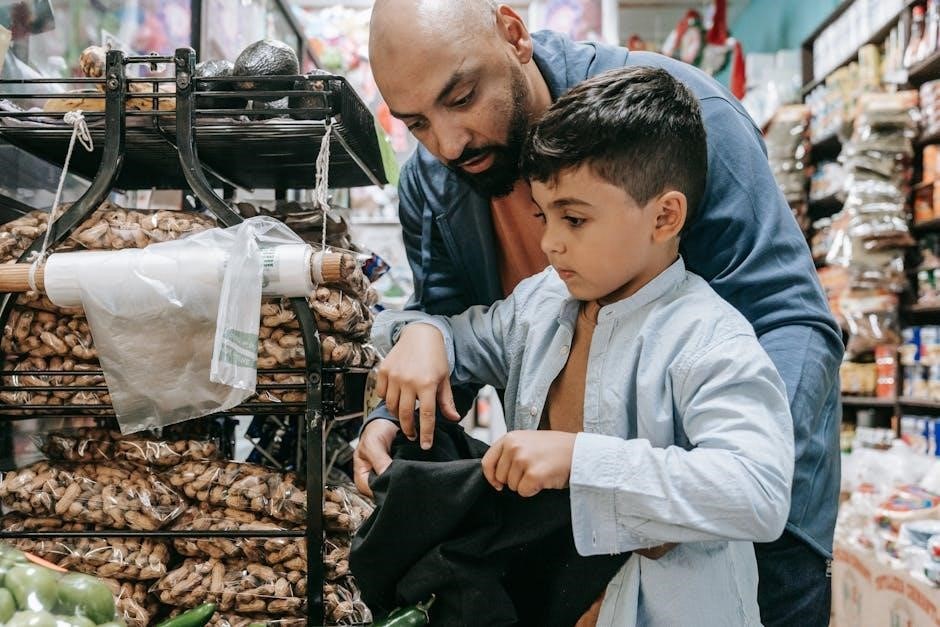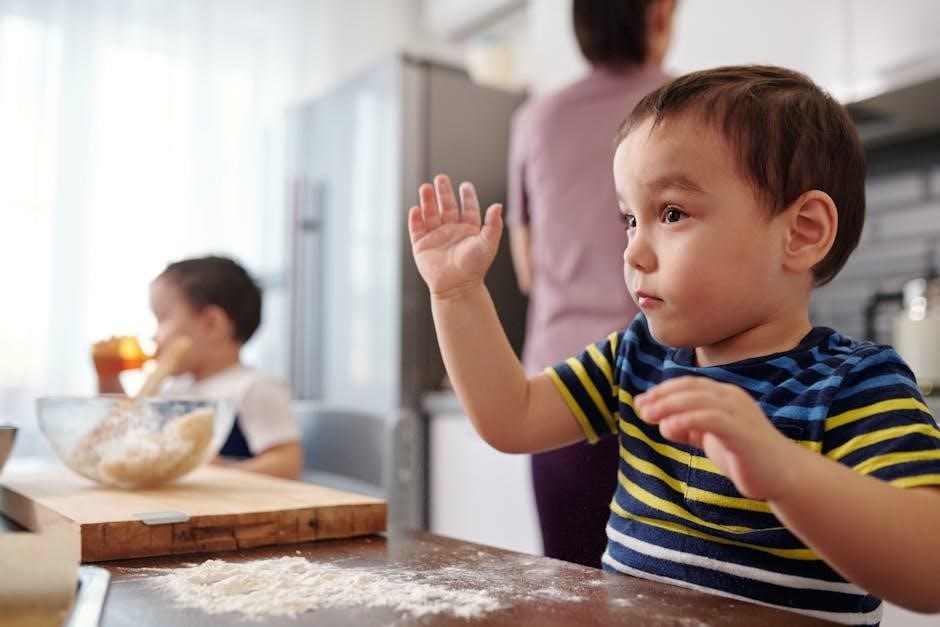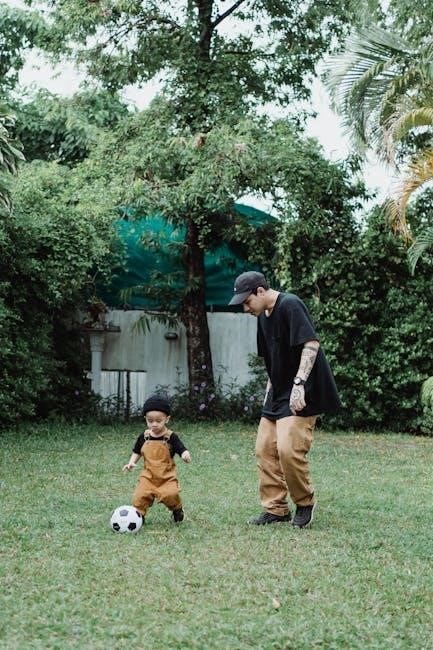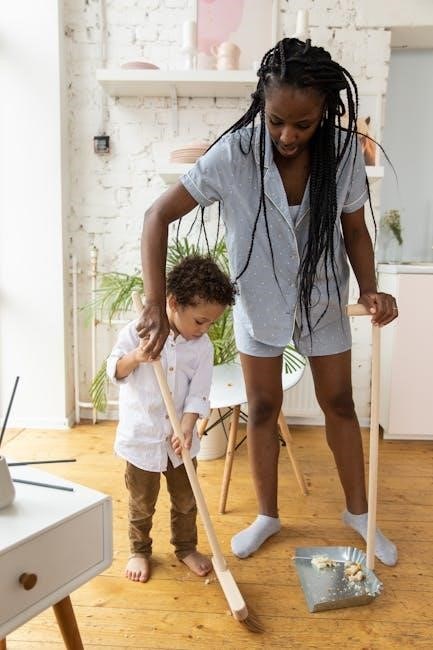Dysfunctional family roles are predictable patterns assumed by members to maintain stability, often stifling personal growth. Roles like the Hero, Scapegoat, and Enabler emerge as coping mechanisms, highlighting the need for understanding and healing.
1.1. Definition and Overview
Dysfunctional family roles refer to the predictable patterns or behaviors adopted by individuals within a family to cope with underlying issues. These roles often emerge as a way to maintain a sense of stability or normalcy, even in chaotic environments. Common roles include the Hero, Scapegoat, Lost Child, Mascot, Caretaker/Enabler, and Mastermind. Each role serves a specific purpose, such as absorbing blame, achieving perfection, or mediating conflicts. These roles are typically rigid and limiting, preventing healthy growth and development. They act as a form of continuity, offering a false sense of order but ultimately perpetuating dysfunction. Understanding these roles is crucial for addressing their impact on family dynamics and individual well-being.
1.2. Importance of Understanding Family Roles
Understanding dysfunctional family roles is essential for breaking cycles of harm and fostering healthier relationships. Recognizing these patterns allows individuals to identify how their behaviors and emotions may be influenced by their family system. This awareness is the first step toward personal growth and healing. By understanding their roles, individuals can challenge and change harmful behaviors, leading to improved mental and emotional well-being. Additionally, this knowledge helps in developing empathy and setting boundaries, which are crucial for building stronger, more functional family dynamics. Awareness also empowers individuals to disrupt intergenerational patterns, creating a more positive environment for future generations. This understanding is transformative and liberating, offering a path to recovery and healthier family interactions.

Common Dysfunctional Family Roles
Dysfunctional family roles include the Hero, Scapegoat, Lost Child, Mascot, Caretaker, and Mastermind. These roles often emerge as coping mechanisms, influencing behavior and emotional well-being significantly.
2.1. The Hero
The Hero is often the most responsible and high-achieving member of a dysfunctional family; They may take on excessive responsibilities to compensate for the family’s dysfunction, striving for perfection. This role can lead to burnout and an inability to express personal needs. The Hero often gains praise from others, which reinforces their role but may mask underlying emotional struggles. Despite their achievements, they may feel unfulfilled or trapped by the expectations placed upon them. Recognizing this role is crucial for breaking free and pursuing personal growth.
2.2. The Scapegoat
The Scapegoat is often blamed for the family’s dysfunction, absorbing criticism and negativity. This role can lead to feelings of guilt, shame, and low self-esteem. Scapegoats may become hypersensitive and develop rebellious or acting-out behaviors as a way to cope. They often struggle with self-worth, believing they are inherently flawed. This role can serve to divert attention from the family’s real issues, such as addiction or abuse. Recognizing this pattern is essential for breaking free and reclaiming personal identity. The Scapegoat’s journey toward healing involves challenging false beliefs and developing healthier ways to cope with emotional pain.
2.3. The Lost Child
The Lost Child is often the forgotten member of a dysfunctional family. They may withdraw emotionally and isolate themselves to avoid conflict or attention. This role involves suppressing emotions and needs, leading to feelings of invisibility and disconnection. Lost Children learn to be independent at a young age, sometimes becoming overly self-reliant. Their quiet nature can make them appear unaffected by family turmoil, but internalized pain and loneliness often linger. Healing for the Lost Child involves reconnecting with their emotions and building trust in relationships, allowing them to express their true selves and seek support when needed.
2.4. The Mascot
The Mascot role in a dysfunctional family is typically assumed by the clown or the jokesmith. This individual uses humor or charm to distract from the family’s problems and maintain a sense of normalcy. Their lighthearted exterior often hides unresolved pain and insecurities. Mascots may struggle with taking life seriously or forming deep connections, as their primary function is to keep others comfortable. While their role provides temporary relief, it can prevent the family from addressing underlying issues. Healing for the Mascot involves acknowledging their hidden emotions and developing authentic relationships beyond their entertaining facade.
2.5. The Caretaker/Enabler
The Caretaker/Enabler often takes on the responsibility of managing the family’s emotional needs and problems. They may assume the role of mediator, problem-solver, or even the primary caregiver, especially if addiction or abuse is present. This role is driven by a deep-seated need to feel needed and in control. However, the Caretaker/Enabler frequently sacrifices their own well-being, enabling dysfunctional behaviors rather than addressing them. Over time, this can lead to resentment and burnout. Their actions, though well-intentioned, often perpetuate the family’s dysfunction by masking underlying issues rather than resolving them. Recognizing and breaking this pattern is crucial for personal and familial healing.
2.6. The Mastermind
The Mastermind assumes a controlling role, often manipulating situations to maintain dominance or order. They may use strategies like guilt-tripping or indirect commands to influence others. This role arises from a need to manage chaos or uncertainty, but it can lead to power imbalances and hinder open communication. The Mastermind’s actions, though aimed at control, can prevent family members from addressing underlying issues, fostering an environment of tension and resentment. Recognizing this pattern is essential for promoting healthier family interactions and personal growth. The Mastermind’s influence often perpetuates dysfunction, making it crucial to address and change these behaviors for the family’s well-being.
The Impact of Dysfunctional Family Roles on Children
Dysfunctional family roles deeply affect children, leading to emotional and psychological challenges. Roles like the Hero or Scapegoat can cause identity issues, low self-esteem, or behavioral problems, hindering healthy development and well-being.
3.1. Emotional and Psychological Effects
Children in dysfunctional families often experience profound emotional and psychological distress. Roles like the Hero may lead to perfectionism and anxiety, while the Scapegoat may develop low self-esteem or feelings of guilt. The Lost Child often struggles with emotional detachment, and the Mascot may use humor to mask inner pain. These roles can result in long-term issues such as identity confusion, difficulty trusting others, and an increased risk of mental health disorders like depression or anxiety. The emotional toll can be overwhelming, affecting a child’s ability to form healthy relationships and maintain emotional stability into adulthood.
3.2. Long-Term Consequences on Development
Children raised in dysfunctional families often face significant developmental challenges that persist into adulthood. Roles like the Hero may lead to an overdeveloped sense of responsibility, stifling personal growth and autonomy. The Scapegoat may struggle with self-worth, affecting future relationships and career opportunities. The Lost Child might experience difficulties in forming intimate connections due to emotional detachment. These roles can hinder the development of healthy boundary-setting and decision-making skills, leading to patterns of co-dependency or avoidance. Additionally, the lack of a nurturing environment can delay emotional maturity, making it harder to cope with life’s challenges independently. These effects can ripple through generations if unaddressed.
Characteristics of Dysfunctional Families
Dysfunctional families often exhibit poor communication, emotional distance, and enabling behaviors. Roles like the Hero or Scapegoat emerge, creating an imbalance that hinders healthy emotional and psychological development.
4.1. Lack of Healthy Communication Patterns
In dysfunctional families, communication is often strained or absent. Family members may avoid discussing issues or express themselves passively or aggressively. This lack of openness prevents emotional connection and problem-solving. Instead, misunderstandings and conflicts persist, fostering an environment of tension and mistrust. Without healthy communication, children struggle to develop emotional intelligence, leading to difficulties in future relationships. This breakdown in communication patterns is a hallmark of dysfunctional families, hindering personal growth and perpetuating unhealthy dynamics. Recognizing this is crucial for breaking the cycle and fostering a more supportive family environment.
4.2. Presence of Addiction or Abuse
Addiction or abuse often serves as a coping mechanism in dysfunctional families, further entrenching unhealthy dynamics. Family members may turn to substances or harmful behaviors to escape emotional pain or stress. This not only perpetuates individual suffering but also creates an environment of fear, mistrust, and instability. Abuse, whether physical, emotional, or verbal, can become normalized, distorting a child’s understanding of love and safety. The presence of addiction or abuse exacerbates the dysfunction, making it harder for individuals to break free and develop healthy relationships. These issues often intertwine, creating a cycle that is challenging to overcome without external support or intervention.

Breaking Free from Dysfunctional Family Roles
Recognizing one’s role is the first step toward liberation. Strategies like therapy, self-awareness, and support systems help individuals break free and embrace healthier patterns, fostering personal growth and healing.
5.1. Recognizing and Acknowledging the Role
Recognizing and acknowledging one’s role in a dysfunctional family is a crucial step toward healing. It involves self-reflection and understanding how these roles were adopted to maintain stability. Individuals must identify their specific role, such as the Hero, Scapegoat, or Enabler, and how it has shaped their behavior and emotions. Acknowledgment requires accepting the role without judgment, recognizing the underlying reasons for its adoption, and understanding its impact on personal growth. This awareness is the foundation for breaking free and developing healthier patterns, enabling individuals to move beyond the limitations imposed by these roles and embrace a more authentic self.
5.2. Strategies for Personal Growth and Healing
Healing from dysfunctional family roles involves adopting strategies that promote self-awareness, emotional healing, and healthy relationships. Seeking therapy or counseling can provide guidance and support. Setting boundaries with family members is crucial to break free from toxic patterns. Engaging in self-care practices, such as mindfulness or journaling, helps rebuild self-esteem and emotional resilience. Joining support groups can offer a sense of community and understanding. Challenging and reframing negative beliefs about oneself and one’s role is also essential. Over time, these strategies empower individuals to redefine their identities and develop healthier ways of interacting, fostering personal growth and emotional well-being.

Intergenerational Transmission of Dysfunctional Roles
Dysfunctional family roles are passed down through generations, often unintentionally, as children mimic behaviors and adopt roles they observe, perpetuating cycles without awareness or intervention.

6.1. How Roles are Passed Down Through Generations
Dysfunctional family roles are transmitted through generations via observation, imitation, and repetition of patterns. Children in dysfunctional families often adopt specific roles, such as the Hero or Scapegoat, as coping mechanisms. These roles provide a sense of stability and predictability within an unstable environment. As children grow, they unconsciously carry these roles into their own families, perpetuating the cycle. This intergenerational transmission is reinforced by lack of awareness and unaddressed emotional wounds, making it challenging to break free without intervention or self-reflection. The repetition of these roles highlights the deep-rooted impact of family dynamics on individual behavior and relationships.
6.2. Breaking the Cycle
Breaking the cycle of dysfunctional family roles requires self-awareness, recognition of inherited patterns, and a commitment to change. Individuals must identify how their past roles influence current behaviors and relationships. Therapy, support groups, and education provide tools to challenge and reframe these patterns. Establishing healthy communication and boundaries is crucial. By confronting unresolved trauma and embracing personal growth, individuals can free themselves from rigid roles. This process empowers future generations to develop healthier dynamics, fostering a cycle of resilience and emotional well-being. Awareness and intentional effort are key to transforming legacies of dysfunction into opportunities for healing and positive change.